Table of Contents
Rotary tillers are essential for preparing soil efficiently and are a valuable tool for farmers, gardeners, and landscapers alike.
They help break up compact soil, mix in nutrients, and create a prime planting environment.
Choosing the best rotary tiller for your tractor depends on factors like your soil type, the size of your area, and the specific power of your tractor.
Here’s a comprehensive guide to help you find the perfect rotary tiller for your needs.
What to Consider When Buying a Rotary Tiller for Your Tractor
- Tiller Width: The width of the tiller should match the size of your tractor and the area you intend to till. Wider tillers cover more ground faster, ideal for large farms, while smaller models are better for garden spaces.
- Tilling Depth: The ability to adjust the tilling depth is essential. For instance, tillers that can go 6-8 inches deep will be better suited for preparing vegetable beds, while a shallower depth may be sufficient for landscaping or lawn prep.
- Power Requirements: Always ensure that your tractor has enough horsepower to handle the tiller you choose. A mismatch here could cause excessive strain on your equipment.
- Soil Type Compatibility: Different rotary tillers work better in certain soil types. Some are built for clay-heavy, compacted soil, while others excel in loamy, sandy soils.
- Durability: Look for materials that withstand wear and tear, especially in rocky or dense soil conditions. Hardened steel tines and powder-coated frames enhance longevity.
Top Rotary Tillers for Tractors
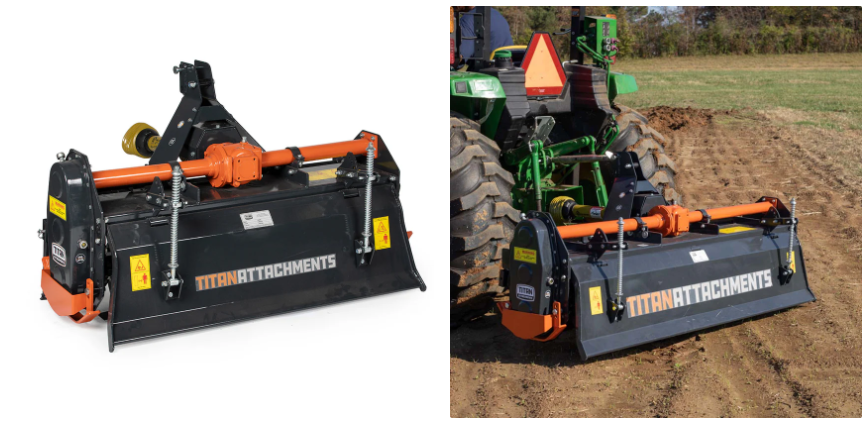
Below is a curated list of some of the best rotary tillers, highlighting their unique features, advantages, and ideal usage scenarios.
1. King Kutter Gear-Driven Rotary Tiller (TG Series)
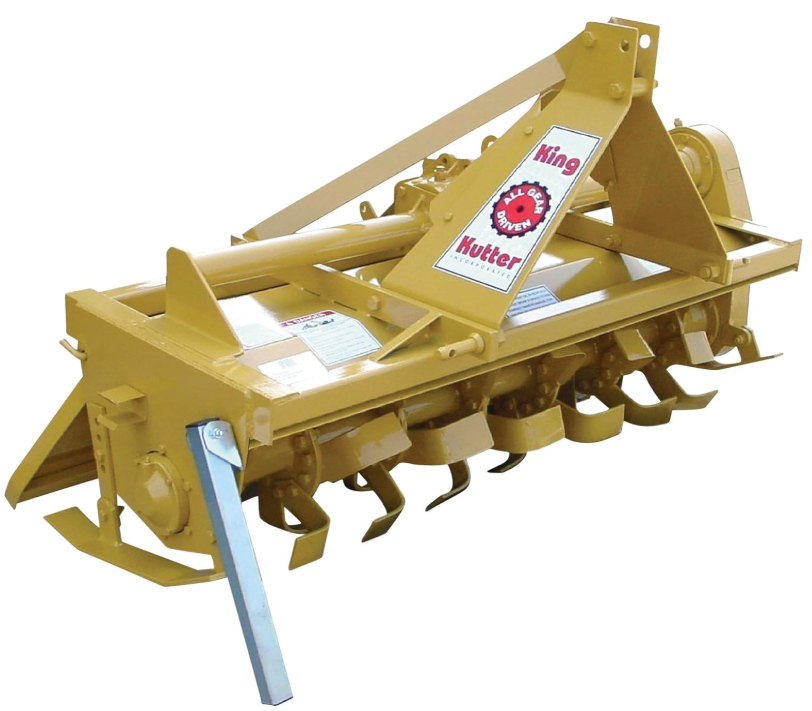
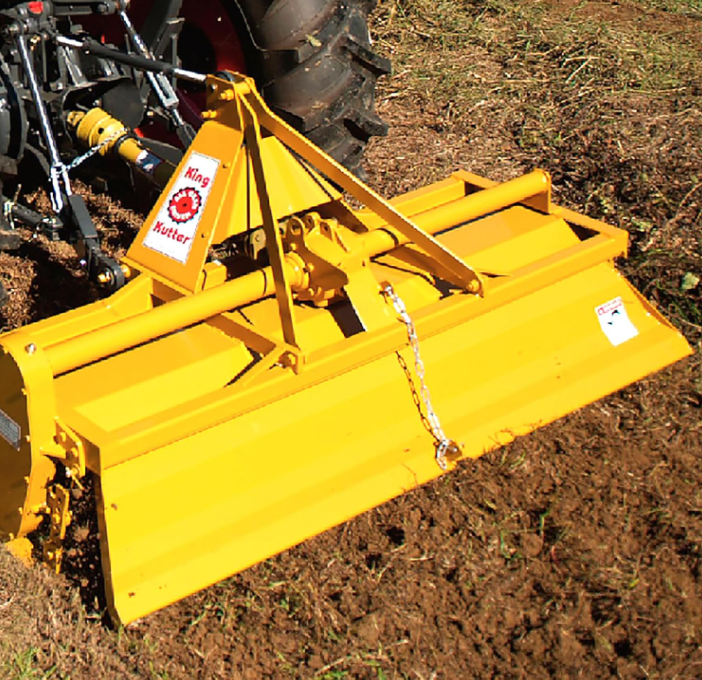
>>Find Prices for all widths of the King Kutter II Rotary Tiller on Amazon<<
- Width Options: 48″ (4 ft), 60″ (5 ft), 72″ (6 ft)
- Power Requirement: 20-50 HP (varies by size; e.g., 25-40 HP for 60″)
- Tine Configuration: 6 tines per flange, L-shaped blades
- Drive Type: Gear-driven
- Tilling Depth: Up to 6-7 inches (adjustable)
- Notable Features:
- Heavy-duty cast iron gearbox for durability and consistent power delivery.
- Slip clutch PTO protection to prevent damage from jams.
- Adjustable skid shoes for depth control.
- Known for reliability in tough soils and professional landscaping tasks.
- Best For: Medium to large gardens, food plots, and professional use with compact or utility tractors.
- Pros: Robust build, smooth operation, widely available replacement parts.
- Cons: May be overkill for small subcompact tractors under 20 HP.
2. Titan 3-Point PTO Tiller
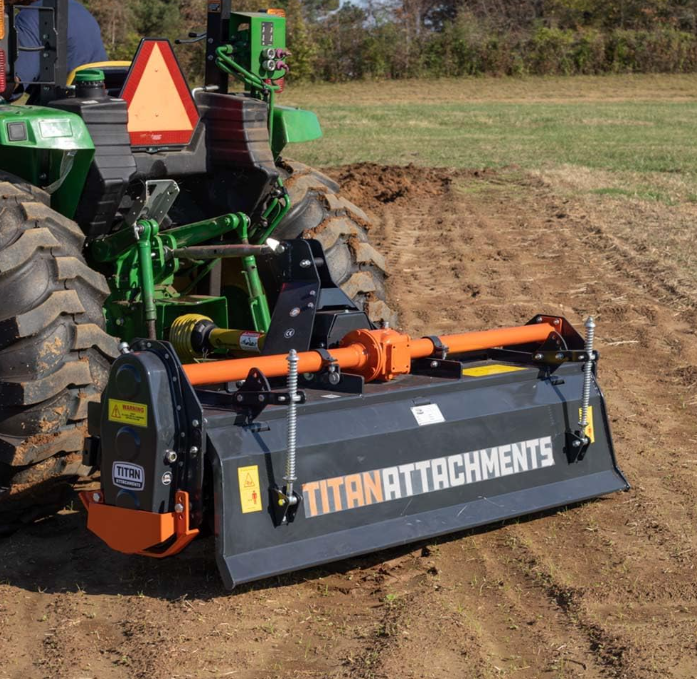
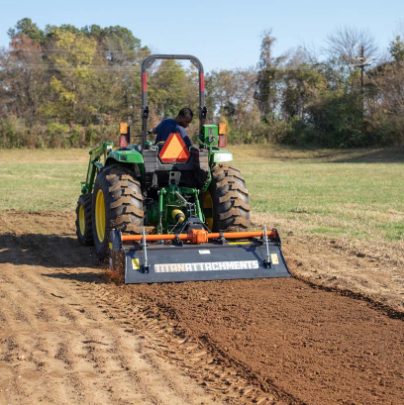
>>Find Current Pricing on Amazon For All Width Titan Tillers<<
- Width Options: 48″ (4 ft), 60″ (5 ft), 72″ (6 ft)Power Requirement: 20-40 HP (e.g., 20-35 HP for 60″)
- Tine Configuration: 28-54 L-shaped tines (varies by width; e.g., 42 tines for 60″)
- Drive Type: Gear-driven
- Tilling Depth: Up to 6 inches (adjustable via ski height settings)
- Notable Features:
- Gear-operated mechanism reduces wear compared to chain drives.
- Adjustable side runners for versatility on uneven terrain.
- Maintenance-free oil-bath transmission.
- Compatible with Category 1 three-point hitches.
- Best For: Large-scale tilling, breaking virgin soil, and heavy-duty tasks.
- Pros: Covers wide areas efficiently, quiet operation, durable construction.
- Cons: Heavier weight (e.g., 700+ lbs for 72″) requires a capable tractor.
3. Farmer Helper Rotary Tiller (FH Series)
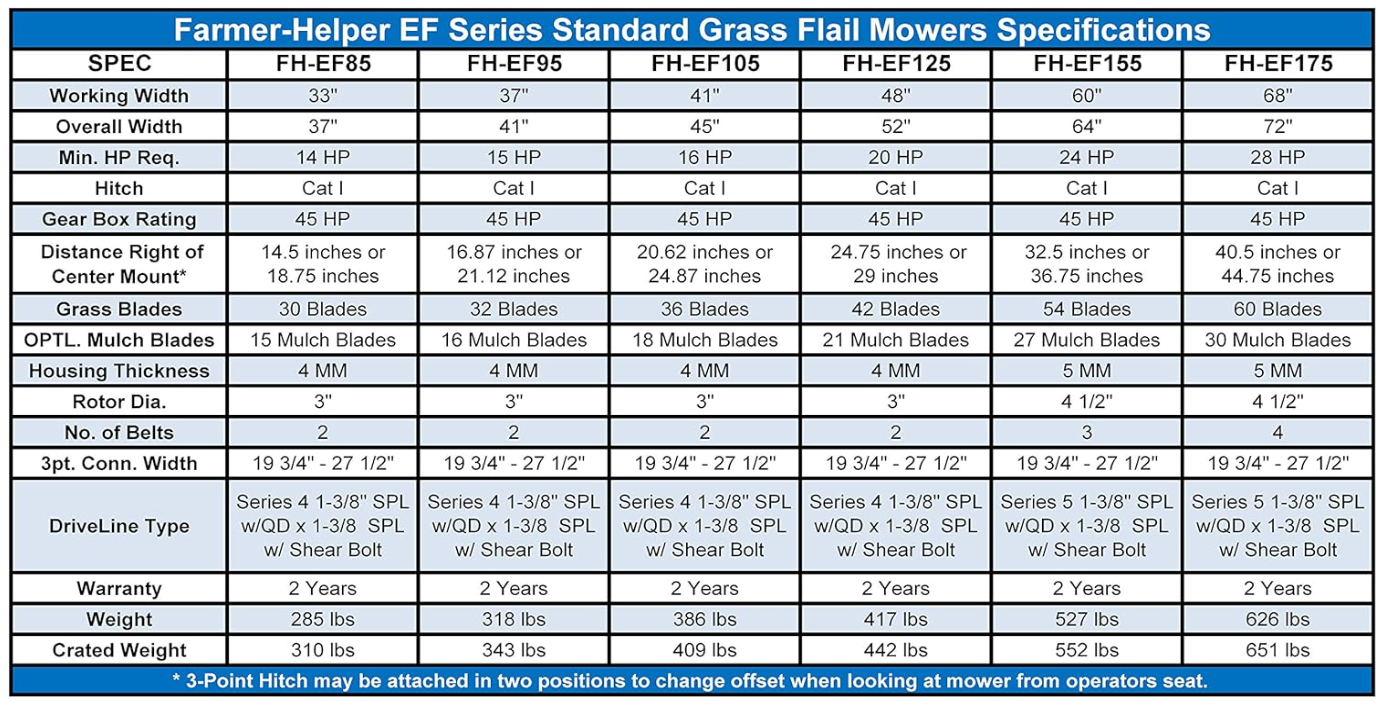
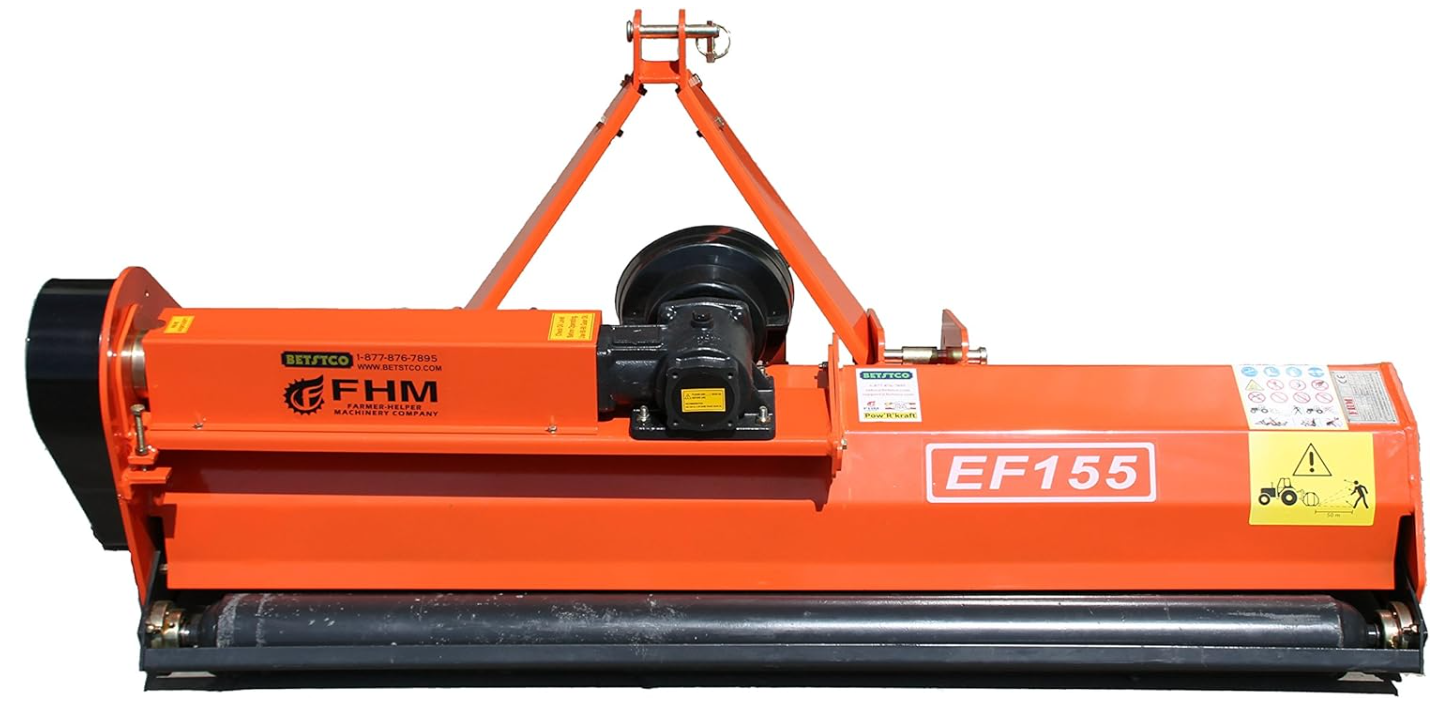
>>Find Current Prices on Amazon for the Farmer Helper Rotary Tiller<<
- Width Options: 48″ (4 ft), 53″ (offset model), 60″ (5 ft)
- Power Requirement: 15-30 HP (ideal for subcompact tractors)
- Tine Configuration: 4 or 6 tines per flange (model-dependent), L-shaped blades
- Drive Type: Chain-driven (some models offer gear-driven options)
- Tilling Depth: Up to 6 inches (adjustable)
- Notable Features:
- Compact design suits smaller tractors like Kubota BX or John Deere 1-Series.
- Offset option (e.g., 53″) covers tire tracks on wider tractors.
- Rear cover aids in soil mixing and rock protection.
- 2-year warranty included.
- Best For: Small to medium gardens, homeowners with subcompact tractors.
- Pros: Lightweight, affordable, easy to maneuver.
- Cons: Chain drive may require more maintenance than gear-driven models.
4. Yardmax YT4565 Compact Rotary Tiller

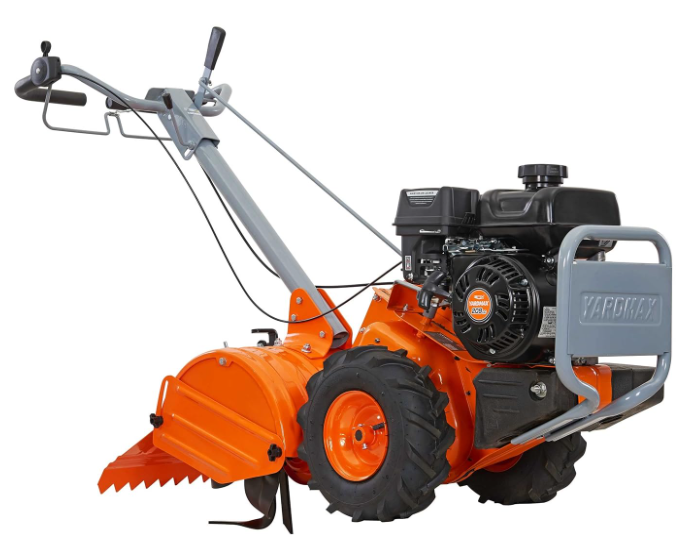

>>See prices for the Yardmax Tiller on Amazon<<
- Width Options: 18 inches (fixed width)
- Power Requirement: Self-powered; 209cc Yardmax engine (9.2 ft-lbs torque, 155.5 RPM) or earlier 208cc Briggs & Stratton (9.5 ft-lbs torque, 190 RPM), depending on model/version
- Tine Configuration: 10 self-sharpening L-shaped tines (5 per side)
- Drive Type: Gear-driven transmission (self-propelled with forward/reverse gears)
- Tilling Depth: Up to 6.5 inches (adjustable with 7 depth settings via drag bar)
- Notable Features:
- Dual-rotation tines: Forward for cultivation, counter-rotation for deep digging in tough soil.
- Single-hand operation allows steering from either side for improved control.
- 13-inch pneumatic wheels with AG tread for traction on uneven ground.
- Heavy-duty front counterweight and one-piece tine shield enhance stability and durability.
- Adjustable drag bar for precise depth control and balance.
- Best For: Medium-sized gardens, breaking new ground, and heavy-duty homeowner tasks.
- Pros: Powerful engine, versatile tine rotation, ergonomic design, good value for price.
- Cons: Heavy (238 lbs) and not easily portable, gearbox ships dry (requires oil fill), not suited for very small spaces.
Rotary Tiller Features to Look For
- Heavy-Duty Tines: Tines should be durable enough to handle hard and rocky soil. Hardened steel tines are generally the most reliable.
- Gear Drive vs. Chain Drive: Gear drives are known for their durability and low maintenance needs, making them more suitable for heavy-duty tasks. Chain drives are lighter and more affordable but may require more upkeep.
- Adjustable Skid Shoes: Skid shoes allow you to control the tilling depth easily. If you need precision, look for tillers with adjustable skids.
- Safety Features: Protective shields or guards over the tines help prevent rocks or debris from flying out, protecting the user and bystanders.
Maintenance Tips for Your Rotary Tiller
To get the most out of your rotary tiller, follow these maintenance tips:
- Clean the Tines Regularly: Soil can clog up tines, especially if working in clay-heavy or wet conditions. Regularly clean them to maintain efficiency.
- Lubricate Moving Parts: A well-lubricated tiller will function smoothly and last longer. Check the manufacturer’s guidelines on lubrication frequency.
- Check Bolts and Fasteners: Vibration can loosen bolts over time. Regularly check and tighten any loose components.
- Inspect for Wear: Regularly examine the tines and gearbox. Replace any worn or damaged parts promptly to avoid costly repairs.
Choosing the Best Rotary Tiller for Your Needs
Choosing the right rotary tiller depends on a combination of factors, from soil type to tractor compatibility. For larger plots, models like the King Kutter II or Bush Hog RTC50G series offer the power and width to till large areas efficiently. Smaller plots or garden spaces are best served by compact options like the Yardmax YT4565 or the Land Pride RTA1258.
A rotary tiller is an investment that can save you time, energy, and effort in the long run. By considering your specific needs and regularly maintaining your equipment, you’ll get years of effective tilling, setting the stage for healthy crops and beautiful gardens.